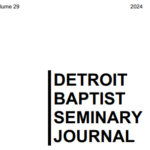Analysis and Critique of the Federal Vision Teaching of Justification (Part 2)
Read Part 1 of this series here.
Teaching Indirectly Related to Justification
As was stated in my previous post, FV is not primarily concerned with soteriology, much less justification. However, some of their teaching in other areas helps to shape their understanding of justification. Three areas that indirectly relate to their teaching of justification will be considered here: the covenant of works, baptism, and union with Christ.
Covenant of Works in Federal Vision
The understanding of the covenant is a major part of FV. Proponents argue that the Reformed church has allowed dispensational thinking to cause them to accept a false distinction between law and gospel and between the Old and New Covenants.[1] This distinction comes in part because the Reformed church has, they argue, mistakenly taught a covenant of works for Adam in the garden. Adam was not in a covenant of works but a covenant of grace. Those who teach a covenant of works are basing their teaching on a false concept of merit that fails to understand the relationship between God and Adam. Adam was not an employee who could earn merit but a son who would receive everything by grace.[2] It also fails to recognize the Creator/creature distinction. The creature is in debt to his Creator and, thus, can never merit anything from him.[3] Adam was not supposed to perfectly obey God in order to gain eternal life. Instead, he was to mature through his faithful obedience to a point where God would graciously grant him a glorified life.[4] Every other covenant in the Scripture follows this same pattern of grace, containing both promises and obligations.[5] Salvation is never earned through meritorious works but is graciously given to those who faithfully obey the obligations of the covenant. Thus, they argue that there is really only one covenant in different forms throughout Scripture: a covenant of grace.
Critique of Covenant of Works in Federal Vision
A complete defense of a covenant of works will not be presented here.[6] Instead, the concept of merit will be briefly considered. While it is true that a creature cannot inherently earn merit with his Creator, this denial of merit altogether fails to distinguish between strict merit and covenantal merit.[7] As a creature, man can earn no strict merit before God. But within a covenant, it is possible to earn covenantal merit by fulfilling a condition in the covenant that the Creator has chosen to establish. The same is true for a father/son relationship. If a father determines to pay his son an agreed-upon amount for doing chores, his filial relationship does not negate the son’s ability to earn wages from his father through fulfilling assigned tasks, nor does it mean that his payment is only from grace.[8]
Baptism in Federal Vision
One of the main issues in FV revolves around the nature of baptism and infant baptism. Those in FV argue that when baptism is used in the New Testament, it refers to the rite of water baptism unless there is strong contextual evidence to the contrary.[9] Thus, what Paul states in Romans 6:1–7 and 1 Corinthians 12:13 shows that baptism is the normal means of union with Christ. All baptized people are brought into the body of Christ and united with Him.[10] Therefore all baptized infants are in the body of Christ and united with Him. That does not mean that baptism saves them. Rather, infants are baptized because they are Christians and fully belong to Christ.[11]
Critique of Baptism in Federal Vision
A full response to this issue lies outside the scope of this paper.[12] However, it will be helpful to notice two things. First, that Paul has water baptism in view in Romans 6 and 1 Corinthians 12 is largely contested. If these passages are speaking simply of water baptism, then the Holy Spirit must be operative in every act of water baptism, a concept which FV teachers seem hesitant to conclude.[13] Second, that all baptized infants are Christians in every sense of the word would seem to argue against what Paul states elsewhere—namely, that the outward possession of the sign is no indication of true inward possession. The difference between the outward sign and inward reality seems to be largely what Paul argues in Romans 2.[14] It is unlikely that Paul would consider all baptized people truly part of the body of Christ.
Union with Christ in Federal Vision
One of the overriding arguments in FV is that a covenant is a relationship. It is not an agreement or a means to a relationship. It is the relationship. When they speak of the covenant, they are referring to Christ.[15] To be in the covenant is to be in Christ. Thus, all those who are baptized members of the visible church are really united with Christ.[16] By their union with Christ, they receive all the spiritual blessings in Christ (sanctification, the Holy Spirit, regeneration, forgiveness, etc.) No distinction exists between those who will later apostatize and those who persevere in regard to their relationship with Christ.[17] This teaching rests in large part on the Scriptural writers’ practice of referring to all those in the church as being elect, in Christ, etc., even though not all would persevere (e.g., Romans 1:7; cf. 11:17-24).
Critique of Union with Christ in Federal Vision
First, FV fails to recognize the contractual nature of a covenant.[18] That a covenant is an agreement has received almost universal recognition among theologians.[19] This is a critical and foundational error upon which much of FV teaching is built. Second, FV proponents fail to recognize the judgment of charity that the writers of Scripture employ in referring to the recipients of their letters. The writers, with finite human knowledge, could not distinguish between temporary and lasting faith.[20] Thus, all who professed faith in Christ were referred to as being in Christ and beneficiaries of all the spiritual blessings in Christ—on the assumption that their faith was genuine. That does not mean that the writers knew that all to whom they wrote were really in Christ; but that, out of charity, they assumed their recipients were in Christ based on their profession.
This post has examined the Federal Vision on issues not directly related to their teaching on justification, but that still shape their view of justification. The next post will examine the Federal Vision view of justification directly.
Read Part 3 of this series here.
[1] See, e.g., Steve Schlissel, “Justification and the Gentiles,” in The Federal Vision, ed. Steve Wilkins and Duane Garner (Monroe, LA: Athanasius Press, 2004), 258.
[2] See, e.g., James B. Jordan, “Merit versus Maturity” in The Federal Vision, ed. Steve Wilkins and Duane Garner (Monroe, LA: Athanasius Press, 2004), 153–158.
[3] See, e.g., Rich Lusk, “A Response to ‘The Biblical Plan of Salvation,’” in The Auburn Avenue Theology Pros and Cons, ed. E. Calvin Beisner (Fort Lauderdale, FL: Knox Theological Seminary, 2004), 121.
[4] See, e.g., Jordan, “Merit versus Maturity,” 164–165.
[5] See Norman Shepherd, The Call of Grace (Phillipsburg, NJ: P & R, 2000), 63.
[6] For a defense see John Bolt, “Why the Covenant of Works is a Necessary Doctrine” in By Faith Alone, ed. Gary L. W. Johnson and Guy P. Waters (Wheaton, IL: Crossway Books, 2006), 171–89; and H. Morton Smith, “Biblical Plan of Salvation” in The Auburn Avenue Theology Pros and Cons, ed. E. Calvin Beisner (Fort Lauderdale, FL: Knox Theological Seminary, 2004), 97-104.
[7] E. Calvin Beisner, “Concluding Comments on the Federal Vision” in The Auburn Avenue Theology Pros and Cons, ed. E. Calvin Beisner (Fort Lauderdale, FL: Knox Theological Seminary, 2004), 324–5 footnote 53.
[8] More concerning the concept of merit will be said in a future post under the discussion of the imputation of Christ’s righteousness.
[9] Leithart, The Baptized Body, 32–34.
[10] Ibid, 84.
[11] Steve M. Schlissel, “A Response to ‘Covenant and Salvation,’” in The Auburn Avenue Theology Pros and Cons, ed. E. Calvin Beisner (Fort Lauderdale, FL: Knox Theological Seminary, 2004), 93–4.
[12] Some of the problems lie in the basic concept of paedo-baptism. However, most who practice paedo-baptism still distinguish between the sign (baptism) and the thing signified (regeneration).
[13] For this critique see Waters, The Federal Vision and Covenant Theology, 195.
[14] Richard D. Phillips, “Covenant and Salvation, or What is a ‘Christian?’” in The Auburn Avenue Theology Pros and Cons, ed. E. Calvin Beisner (Fort Lauderdale, FL: Knox Theological Seminary, 2004), 79.
[15] See, e.g., Schlissel, “A Response to ‘Covenant and Salvation,’” 91.
[16] So, e.g., Wilson, “Union with Christ,” 5–6.
[17] Steve Wilkins, “Covenant, Baptism, and Salvation,” in The Auburn Avenue Theology Pros and Cons, ed. E. Calvin Beisner (Fort Lauderdale, FL: Knox Theological Seminary, 2004), 261–263.
[18] Joseph A. Pipa Jr., “A Response to ‘Covenant, Baptism, and Salvation,’” in The Auburn Avenue Theology Pros and Cons, ed. E. Calvin Beisner (Fort Lauderdale, FL: Knox Theological Seminary, 2004), 271.
[19] Phillips, “Covenant and Salvation,” 78.
[20] R. Fowler White, “Covenant and Apostasy” in The Auburn Avenue Theology Pros and Cons, ed. E. Calvin Beisner (Fort Lauderdale, FL: Knox Theological Seminary, 2004), 212–213.



